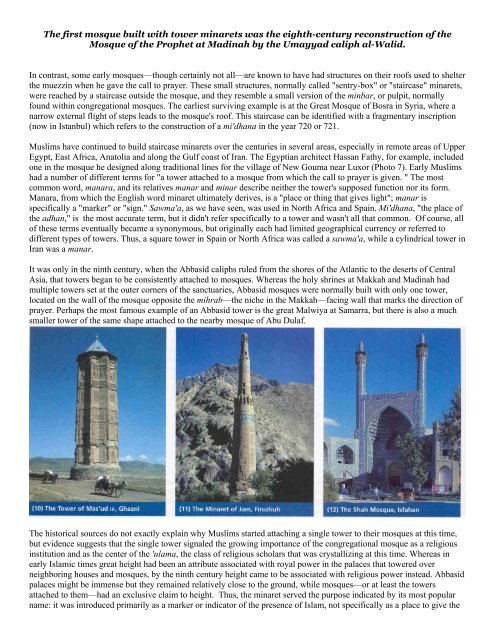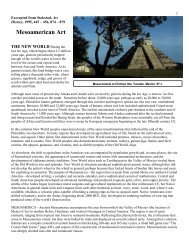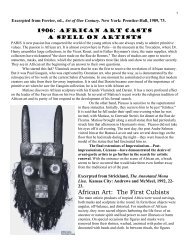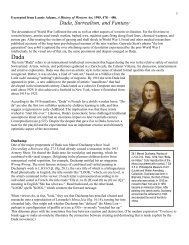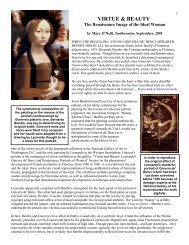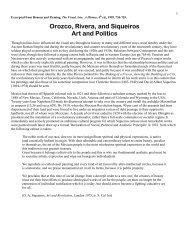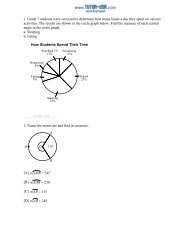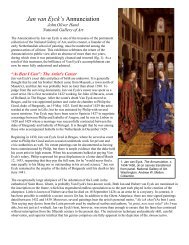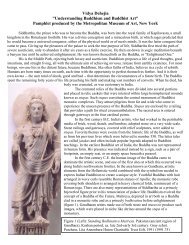The Minaret, Symbol of Power and Faith, Aramco World, MarAp.pdf
The Minaret, Symbol of Power and Faith, Aramco World, MarAp.pdf
The Minaret, Symbol of Power and Faith, Aramco World, MarAp.pdf
Create successful ePaper yourself
Turn your PDF publications into a flip-book with our unique Google optimized e-Paper software.
<strong>The</strong> first mosque built with tower minarets was the eighth-century reconstruction <strong>of</strong> theMosque <strong>of</strong> the Prophet at Madinah by the Umayyad caliph al-Walid.In contrast, some early mosques—though certainly not all—are known to have had structures on their ro<strong>of</strong>s used to shelterthe muezzin when he gave the call to prayer. <strong>The</strong>se small structures, normally called "sentry-box" or "staircase" minarets,were reached by a staircase outside the mosque, <strong>and</strong> they resemble a small version <strong>of</strong> the minbar, or pulpit, normallyfound within congregational mosques. <strong>The</strong> earliest surviving example is at the Great Mosque <strong>of</strong> Bosra in Syria, where anarrow external flight <strong>of</strong> steps leads to the mosque's ro<strong>of</strong>. This staircase can be identified with a fragmentary inscription(now in Istanbul) which refers to the construction <strong>of</strong> a mi'dhana in the year 720 or 721.Muslims have continued to build staircase minarets over the centuries in several areas, especially in remote areas <strong>of</strong> UpperEgypt, East Africa, Anatolia <strong>and</strong> along the Gulf coast <strong>of</strong> Iran. <strong>The</strong> Egyptian architect Hassan Fathy, for example, includedone in the mosque he designed along traditional lines for the village <strong>of</strong> New Gouma near Luxor (Photo 7). Early Muslimshad a number <strong>of</strong> different terms for "a tower attached to a mosque from which the call to prayer is given. " <strong>The</strong> mostcommon word, manara, <strong>and</strong> its relatives manar <strong>and</strong> minar describe neither the tower's supposed function nor its form.Manara, from which the English word minaret ultimately derives, is a "place or thing that gives light"; manar isspecifically a "marker" or "sign." Sawma'a, as we have seen, was used in North Africa <strong>and</strong> Spain. Mi'dhana, "the place <strong>of</strong>the adhan," is the most accurate term, but it didn't refer specifically to a tower <strong>and</strong> wasn't all that common. Of course, all<strong>of</strong> these terms eventually became a synonymous, but originally each had limited geographical currency or referred todifferent types <strong>of</strong> towers. Thus, a square tower in Spain or North Africa was called a sawma'a, while a cylindrical tower inIran was a manar.It was only in the ninth century, when the Abbasid caliphs ruled from the shores <strong>of</strong> the Atlantic to the deserts <strong>of</strong> CentralAsia, that towers began to be consistently attached to mosques. Whereas the holy shrines at Makkah <strong>and</strong> Madinah hadmultiple towers set at the outer corners <strong>of</strong> the sanctuaries, Abbasid mosques were normally built with only one tower,located on the wall <strong>of</strong> the mosque opposite the mihrab—the niche in the Makkah—facing wall that marks the direction <strong>of</strong>prayer. Perhaps the most famous example <strong>of</strong> an Abbasid tower is the great Malwiya at Samarra, but there is also a muchsmaller tower <strong>of</strong> the same shape attached to the nearby mosque <strong>of</strong> Abu Dulaf.<strong>The</strong> historical sources do not exactly explain why Muslims started attaching a single tower to their mosques at this time,but evidence suggests that the single tower signaled the growing importance <strong>of</strong> the congregational mosque as a religiousinstitution <strong>and</strong> as the center <strong>of</strong> the 'ulama, the class <strong>of</strong> religious scholars that was crystallizing at this time. Whereas inearly Islamic times great height had been an attribute associated with royal power in the palaces that towered overneighboring houses <strong>and</strong> mosques, by the ninth century height came to be associated with religious power instead. Abbasidpalaces might be immense but they remained relatively close to the ground, while mosques—or at least the towersattached to them—had an exclusive claim to height. Thus, the minaret served the purpose indicated by its most popularname: it was introduced primarily as a marker or indicator <strong>of</strong> the presence <strong>of</strong> Islam, not specifically as a place to give the


